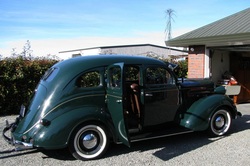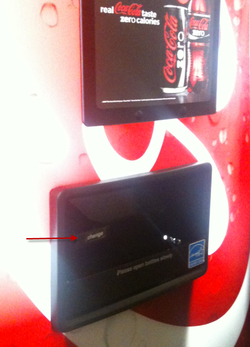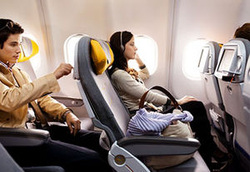|
I first became interested in industrial design upon learning of "suicide doors." Early cars were often designed with doors that hinged behind the passenger. On one hand, this was an excellent design: it allowed passengers to enter and exit vehicles with great ease. However, there was one major flaw. In the event of an emergency exit, the doors would catch and drag the passenger. Hence the name: "suicide doors." Today, there are numerous examples of "suicide door" designs, i.e. grand intentions but disastrous flaws. There are also designs that are so simple and obvious that you find yourself scratching your head and wondering: "Why did it take XYZ company so long to come up with this?" Below are two designs that gave me pause. As I spot more designs, I'll share them here as an ongoing series. Please send me any design examples that you feel deserve mention in the either the Hall of Fame or Hall of Shame. Coca-Cola Vending Machine: A simple design shift reduces motion and prevents you from forgetting change A few weeks ago, a new vending machine was delivered to my office. It seemed like a standard vending machine: seven-ish feet tall, glowing lights, the constant hum of a refrigeration motor. This machine, however, had a minor modification. Typically, vending machines collect money and dispense change in the same area: the right side about 5 feet from the floor. The two functions - taking money and giving change - are similar so it is logical that they be placed in the same vicinity, right? Not necassarily, as this machine proves. In the new machine, the change and the soda are dispensed in the same area. The benefits are less movement and a lower chance of forgetting your change. Under the old design: you insert your money, chose your soda, collect your soda, and then return to to "money area" to collect your change. The new design completely removes the last movement of returning to the "money area" because the collecting the soda and the change movement are integrated into one. This is a 25% reduction in movement. A web or mobile designer that reduces the number of clicks to make a purchase by 25% would be considered a rock star. In summary, the key lesson from the Coke machine is that similar functions do not need to be performed in the same physical area. Touchscreens on Headrests: Or how I tried to relax while someone played Tetris on the back of my skull. No one can complain about personal televisions on airplanes. Good riddance to the days of being forced to watch such classics as Flubber or Legally Blonde 2.* Welcome to a world of live television and on demand movies. The design, however, fails in the way passengers operate the televisions. Some - not all - airlines have adopted touchscreens. The benefit of the touchscreen is that the airline does not need to install and maintain separate remotes. The disadvantage - the "suicide door" if you will - is that the touchscreen is directly in back of the person sitting in front of you. Every channel change or volume adjustments results in a slight but agitating tap to the back of the head. The problem is exacerbated by two factors: first, people unfamiliar with touchscreens who do not realize you just have to gently tap, not violently push; and the introduction of touch-based video games. In summary, well designed products and solutions cannot adversely affect others. I call this the "secondhand smoke test" or "libertarian test." Whatever name you chose, airplanes with touchscreen televisions flunk. ---------------------------------------------------------- *This is not a gibe at the original Legally Blonde, which was awesome.
3 Comments
A few weeks ago our friend from Delhi, India visited. As a WSJ reporter, Shefali is naturally inquisitive, so she asked: "Jon, what was your reaction to the Bin Laden death?"
After some thought, I responded: "It made me realize exactly how much technology has changed over the past decade." Flash back to Tuesday September 11, 2001. I was driving from Jackson, MI to Mackinac Island. I was anxiously watching the clock because at 9 AM I needed to find a store that sold CDs. Bob Dylan's Love And Theft album was dropping; as a huge Dylan fan I could not wait to hear the follow-up to the near flawless Time Out of Mind. I pulled off at a few exits but came up empty. Finally, I found a Walmart in Mt. Pleasant. I was no more than fifteen feet into the Supercenter when a man came up to me. "We're under attack!" "What?" I asked the man. He was straddling the line between burly and obese, and dressed in camouflage. "They - Saudi Arabia - or one of those countries - attacked New York." To this day, I'm still impressed that the man fingered Islamic extremists. My initial reaction, I'm embarrassed to say, was Russia, maybe China. A decade since the end of the Cold War and that was still my lens. After digesting the news in the electronics section, we canceled the Mackinac trip and turned back to Jackson. When we arrived home, we tuned into cable news. Like fifty percent of the homes in the nation, the house did not have Internet. With the Towers felled, the Pentagon ablaze and a mysterious plane down in Pennsylvania I was left with one final task: find out how my friends in New York and Washington were doing. I paced around the house, dialing friend after friend on an old, clunky cordless phone. At 7 PM, I switched to my Motorola StarTac. Flash forward to May 1, 2011. In many ways, very little has changed. We still put pants on in the morning, use a stove to cook breakfast, a car to get around. When it is hot, we put on air conditioning; when it is cold we turn up the thermostat. The way we gather and share information, however, has changed dramatically. Music is the first example. September 2001 was the crossroads for the music industry. In the preceding months, Napster launched, disrupted the music industry forever, and then shuttered. The world had a taste for digital distribution but there was no easy-to-use, reliable portable music system. That would not happen for another two months: Apple shipped the first iPod on November 10, 2001. So on that fateful morning when I wanted my Dylan, I knew the CD would soon be anachronistic but it was the only solution. And I wasn't alone. Music sales hovered around $14b in 2001. Today, sales are half that and falling precipitously. Perhaps the biggest revolution during the 10 years between September 11 and Bin Laden's death is the ubiquity of the Internet and the platforms it has enabled. In 2001, it was completely normal for a middle-class, educated home in the richest nation on the planet to not have Internet. Now, not only do most American's have Internet but the Internet has become accessible and powerful in developing nations, such as Pakistan. Over the last decade, Internet access in Pakistan has grown 1,000-fold to reach 10% of the population, or about 17 million people. In short, we've gone from a world where a comfortable American could not email friends from home to one in which a man in Abbottabad, Pakistan can broadcast - in real time and at zero cost - the raid on Bin Laden's compound. Lastly, and most obviously, the way we connect has changed. In 2001, communication was "one-to-one," meaning I called or emailed friend X, then friend Y and so on. Facebook and Twitter, which would not be invented for another two and half years and five years, respectively, enable "one-to-many" communications. These services are incredibly efficient during times of distress. Had Facebook been as ubiquitious as it is today, it would have taken me just a few seconds to learn the status of the dozen or so people I knew in New York. |
JONATHAN STEIMAN
I'm the Founder and CEO of Peak Support. This blog is my take on early-stage companies and innovation. Every so often, there may be a post about culture, networking, family -- you name it. After all, what is a blog if it isn't a tad bit unstructured.
Archives
December 2016
Categories
All
|



